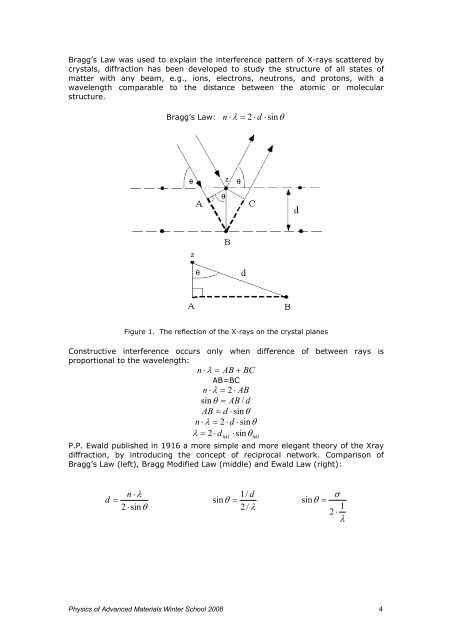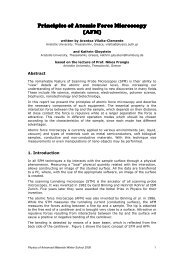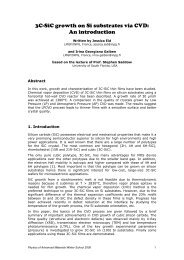The Röntgen Radiation and its application in studies of ... - Mansic
The Röntgen Radiation and its application in studies of ... - Mansic
The Röntgen Radiation and its application in studies of ... - Mansic
You also want an ePaper? Increase the reach of your titles
YUMPU automatically turns print PDFs into web optimized ePapers that Google loves.
Bragg’s Law was used to expla<strong>in</strong> the <strong>in</strong>terference pattern <strong>of</strong> X-rays scattered by<br />
crystals, diffraction has been developed to study the structure <strong>of</strong> all states <strong>of</strong><br />
matter with any beam, e.g., ions, electrons, neutrons, <strong>and</strong> protons, with a<br />
wavelength comparable to the distance between the atomic or molecular<br />
structure.<br />
Bragg’s Law: n ⋅ λ = 2 ⋅ d ⋅ s<strong>in</strong>θ<br />
Figure 1. <strong>The</strong> reflection <strong>of</strong> the X-rays on the crystal planes<br />
Constructive <strong>in</strong>terference occurs only when difference <strong>of</strong> between rays is<br />
proportional to the wavelength:<br />
n ⋅ λ = AB + BC<br />
AB=BC<br />
n ⋅ λ = 2 ⋅ AB<br />
s<strong>in</strong> θ = AB / d<br />
AB = d ⋅ s<strong>in</strong>θ<br />
n ⋅ = 2 ⋅ d ⋅<br />
λ s<strong>in</strong>θ<br />
λ = 2 ⋅ d ⋅ s<strong>in</strong>θ<br />
hkl<br />
P.P. Ewald published <strong>in</strong> 1916 a more simple <strong>and</strong> more elegant theory <strong>of</strong> the Xray<br />
diffraction, by <strong>in</strong>troduc<strong>in</strong>g the concept <strong>of</strong> reciprocal network. Comparison <strong>of</strong><br />
Bragg’s Law (left), Bragg Modified Law (middle) <strong>and</strong> Ewald Law (right):<br />
⋅ λ<br />
=<br />
2 ⋅s<strong>in</strong>θ<br />
n<br />
d<br />
Physics <strong>of</strong> Advanced Materials W<strong>in</strong>ter School 2008 4<br />
hkl<br />
1/<br />
d<br />
s<strong>in</strong>θ<br />
=<br />
2 / λ<br />
σ<br />
s<strong>in</strong>θ<br />
=<br />
1<br />
2 ⋅<br />
λ




